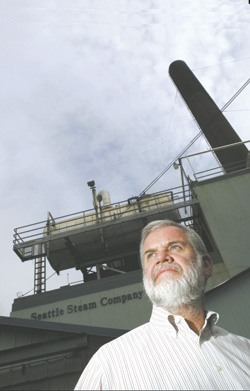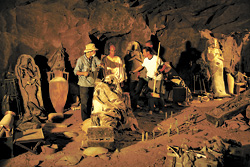The primary steam plant of the Seattle Steam Co. sits at the edge of the waterfront, with a faded mural of dolphins and a whale on its southern facade. Inside, a complex jumble of pipes, valves, and gauges runs proficiently, alongside a few workers in hard hats who ensure that the heat doesn’t stop flowing. And they better: Sixty percent of buildings in and around downtown—including the company’s two largest customers, Harborview and Swedish Medical Centers—rely on Seattle Steam for their heat and hot water.
The company claims to have 99.999 percent availability. The last time service broke down was in late 2004 for an hour.
“It was a big deal for us,” says Seattle Steam CEO Stan Gent, his voice strained. “Over a couple of days, operations were very fickle and everybody was working very hard to overcome the problem. There was failure of a control device. We were manually operating, but everyone was getting heat.”
A privately owned company with only six managers and 20 steam plant employees, Seattle Steam is looking to change from running primarily on natural gas to discarded wood. Gent is still trying to secure enough funding to pay for a new, $18 million wood burner. “We have everything in place, but it’s hard for a small company to raise a lot of money,” Gent says in his slight Irish accent.
The company plans to use broken pallets and junk wood that would normally go to a landfill, then burn it at a high temperature, filtering the smoke, so that it will create less pollution than natural-gas exhaust. “We’re not in a throw-away world anymore,” says Gent. “We want to gather up what the community is creating so it’s not a pain in the ass to deal with.”
The company serves its 175 customers via 18 miles of underground pipe. And since it’s too expensive to expand horizontally, Seattle Steam aims to expand vertically. Last year the city rezoned to allow buildings to scrape more sky, which means more tall buildings—condos, apartments, and offices—will be appearing on the horizon. David Easton, vice president of business development at Seattle Steam, will court the developers every step of the way. He’ll try to convince them that steam is a more efficient option compared to self-maintained boilers.
“Right now, I’m tracking about 50 projects that are coming out of the ground in the next five to eight years,” Easton says..—1325 Fourth Ave., Ste. 1440., 623-6366, www.seattlesteam.com.







